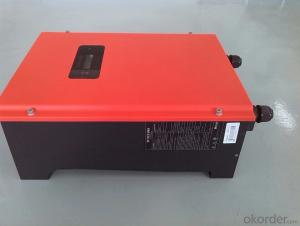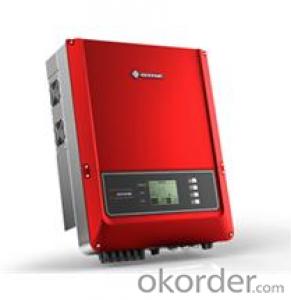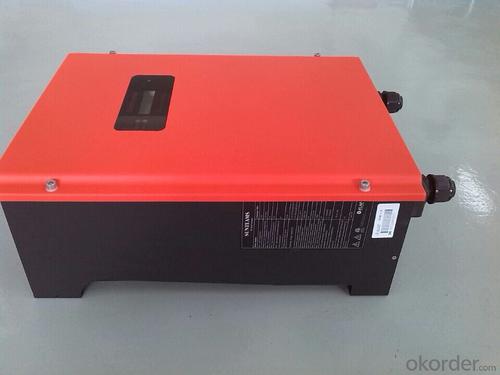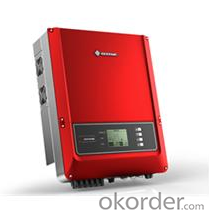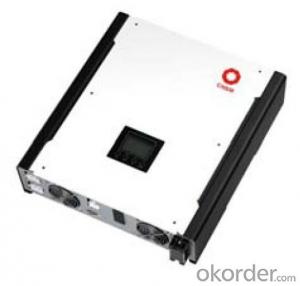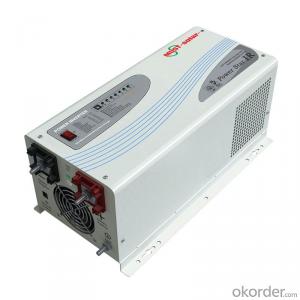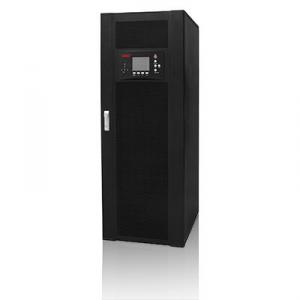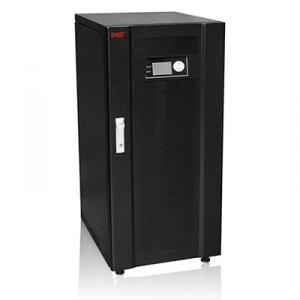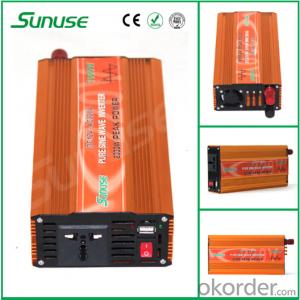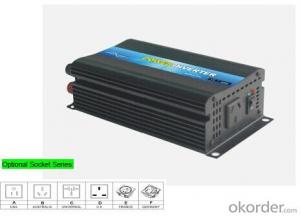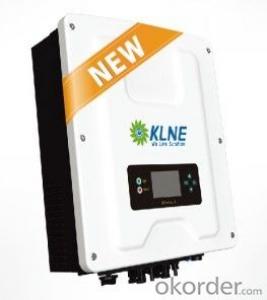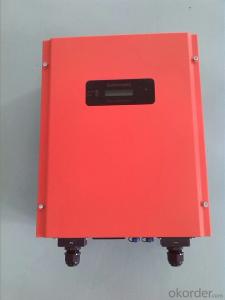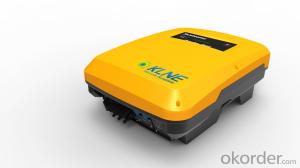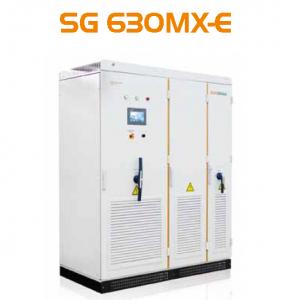Samsung Solar Inverter Off-Grid Type Solartec D 6000/8000
- Loading Port:
- Shanghai
- Payment Terms:
- TT OR LC
- Min Order Qty:
- 10 unit
- Supply Capability:
- 1000 unit/month
OKorder Service Pledge
OKorder Financial Service
You Might Also Like
Product Description:
The photovoltaic grid-connected inverter series of Solartec D 6 - 8 kW are applicable to all types of commercial rooftop projects or grid-connected power plant systems. The nominal output powers of this series are 6 kW and 8 kW respectively.
This series of inverters has 2 string MPP trackers and three level technology. These features ensure the high utilization rate of grid and maximize the system efficiency. The new technology of this series supports the adjustable power factor and grid monitoring, complies to German BDEW medium voltage guidelines and reaches European and Australian certification standards .
Efficient
■ Maximum efficiency 98 %
■ Flexible tracking with two MPP trackers
Reliable
■ Integrated DC switch
■ Three phase grid connection
■ Reliability and long life ensured by film capacitors
Flexible
■ DC input voltage up to 1,000 V
■ Reactive power supply
■ For indoor and outdoor installation
Communicative
■ RS232 / RS485 interfaces as standard
Product Datasheet:
Solartec D 6000 | Solartec D 8000 | |
Input Data | ||
Max. DC Power | 6350 W | 8250 W |
Max. DC Voltage | 1000 V | 1000 V |
System Start-up Voltage | 250 V | 250 V |
Full Load Voltage Range MPPT | 250 V - 800 V | 250 V - 800 V |
Max. Input Current | 2 × 16A | 2 × 16A |
Nominal DC Voltage | 650 V | 650 V |
Number of MPP Trackers | 2 | 2 |
Strings of each MPPT | A : 1, B : 1 | A : 1, B : 1 |
Output Data | ||
Nominal AC Output | 6000 W | 8000 W |
THD of AC Current | < 3.0 % | < 3.0 % |
Nominal Grid Voltage Range | 230 V - 400 V (3/N/PE) | 230 V - 400 V (3/N/PE) |
Nominal Grid Frequency | 50 Hz | 50 Hz |
Adjustable Displacement Factor | 0.9 overexcited...0.9 underexcited | 0.9 overexcited...0.9 underexcited |
Max. Output Current | 10 A | 13 A |
Efficiency |
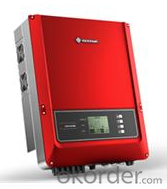
Product Advantages:
Powered by DC current
Can used out of doors
High effiency and low noise
FAQ
What is your payment terms?
We accept T/T payment, normally we need 20% T/T in advance, 80% payed before shipment.
What is your packing system?
We put the sistem in the wooden box.
Can you do OEM service?
Yes we can, but we need to do it with a certain order quantity.
- Q: What is the role of a grid protection relay in a solar inverter?
- The role of a grid protection relay in a solar inverter is to monitor the electrical grid and protect against any abnormalities or faults that may occur. It ensures the safe and reliable operation of the solar inverter by detecting and isolating faults such as overvoltage, undervoltage, overfrequency, underfrequency, and other grid disturbances. The grid protection relay acts as a safeguard, preventing any damage to the solar inverter and maintaining the stability of the grid connection.
- Q: Can a solar inverter be used for residential applications?
- Yes, a solar inverter can be used for residential applications. A solar inverter is an essential component of a residential solar energy system as it converts the direct current (DC) generated by solar panels into usable alternating current (AC) electricity that can power household appliances and be fed back into the grid.
- Q: Does a solar inverter require any additional cooling or ventilation?
- Yes, a solar inverter typically requires additional cooling or ventilation to operate efficiently and prevent overheating. The heat generated during the conversion of DC to AC power needs to be dissipated to maintain optimal performance and prolong the lifespan of the inverter.
- Q: Can a solar inverter be used with different types of tracking algorithms?
- Yes, a solar inverter can be used with different types of tracking algorithms. The primary function of a solar inverter is to convert the direct current (DC) generated by solar panels into alternating current (AC) that can be used in homes or businesses. Tracking algorithms, on the other hand, are responsible for optimizing the performance of solar panels by adjusting their orientation and tilt angles to maximize sunlight exposure. Solar inverters can integrate with various tracking algorithms to ensure efficient operation and improve energy generation.
- Q: Can a solar inverter be used with any type of solar panel?
- Yes, a solar inverter can be used with any type of solar panel as long as the voltage and power output of the panel are compatible with the inverter's specifications.
- Q: What is the role of a solar inverter in a net metering system?
- The role of a solar inverter in a net metering system is to convert the direct current (DC) electricity generated by solar panels into alternating current (AC) electricity that can be used by the grid or consumed in the building. It also ensures that any excess electricity produced by the solar panels is fed back into the grid, allowing the system owner to receive credits or compensation for the surplus energy.
- Q: What is the role of voltage support in a solar inverter?
- The role of voltage support in a solar inverter is to maintain a stable and appropriate voltage level for the solar system. It ensures that the generated solar power is compatible with the electrical grid and devices connected to it, preventing any damage or malfunction. Additionally, voltage support helps optimize the efficiency and performance of the solar inverter, maximizing the power output from the solar panels.
- Q: How does a solar inverter handle voltage fluctuations in the grid?
- A solar inverter handles voltage fluctuations in the grid by continuously monitoring the grid voltage. When the voltage deviates from the standard range, the inverter adjusts its output accordingly to stabilize the voltage and ensure a consistent supply of power.
- Q: Can a solar inverter be used in areas with high seismic activity?
- Yes, a solar inverter can be used in areas with high seismic activity. However, it is essential to ensure that the solar inverter is designed to withstand seismic vibrations and has been installed using appropriate seismic-resistant mounting techniques. Special precautions and engineering considerations may be necessary to ensure the inverter's integrity and functionality during seismic events.
- Q: What is the role of maximum power control in a solar inverter?
- The role of maximum power control in a solar inverter is to optimize the power output of the photovoltaic (PV) system by continuously tracking the maximum power point (MPP) of the solar panels. This control mechanism ensures that the inverter extracts the maximum amount of energy from the PV array, despite variations in solar irradiation and temperature. By constantly adjusting the inverter's operating conditions to match the MPP, maximum power control maximizes the overall efficiency and performance of the solar power system.
Send your message to us
Samsung Solar Inverter Off-Grid Type Solartec D 6000/8000
- Loading Port:
- Shanghai
- Payment Terms:
- TT OR LC
- Min Order Qty:
- 10 unit
- Supply Capability:
- 1000 unit/month
OKorder Service Pledge
OKorder Financial Service
Similar products
Hot products
Hot Searches
Related keywords
